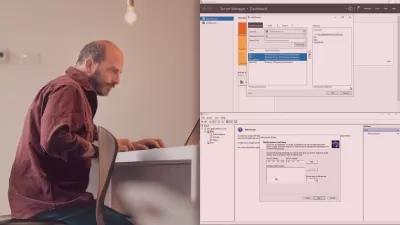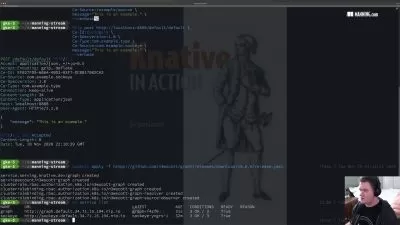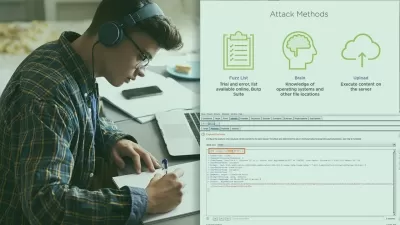Acing the System Design Interiew, Video Edition
Focused View
17:02:10
149 View
Appendix A. Adantages of serices.mp4
05:23
Appendix A. Disadantages of monoliths.mp4
00:49
Appendix A. Disadantages of serices.mp4
11:16
Appendix A. Monoliths s. microserices.mp4
00:59
Appendix A. References.mp4
00:18
Appendix B. Disadantages of simple login.mp4
03:44
Appendix B. OAuth 2.0 authorization and OpenID Connect authentication.mp4
01:21
Appendix B. OAuth 2.0 flow.mp4
10:40
Appendix B. OpenID Connect authentication.mp4
04:00
Appendix B. Other OAuth 2.0 flows.mp4
01:28
Appendix B. Prelude Simple login, cookie-based authentication.mp4
01:55
Appendix B. Single sign-on.mp4
00:59
Appendix C. C4 Model.mp4
07:09
Appendix D. Two-phase commit (2PC).mp4
04:35
Chapter 1. A walkthrough of system design concepts.mp4
03:31
Chapter 1. Oeriew of this book.mp4
01:27
Chapter 1. Prelude A brief discussion of scaling the arious serices of a system.mp4
45:05
Chapter 1. Should you read this book.mp4
04:06
Chapter 1. Summary.mp4
01:30
Chapter 2. A typical system design interiew flow.mp4
10:45
Chapter 2. Connections and processing between users and data.mp4
01:57
Chapter 2. Design the data model.mp4
13:30
Chapter 2. Draft the API specification.mp4
02:20
Chapter 2. Interiewing the company.mp4
06:01
Chapter 2. Logging, monitoring, and alerting.mp4
19:48
Chapter 2. Other discussions.mp4
08:25
Chapter 2. Post-interiew reflection and assessment.mp4
09:02
Chapter 2. Search bar.mp4
09:56
Chapter 2. Summary.mp4
01:53
Chapter 3. Aailability.mp4
03:19
Chapter 3. Accuracy.mp4
01:32
Chapter 3. Cloud natie.mp4
01:38
Chapter 3. Complexity and maintainability.mp4
03:42
Chapter 3. Consistency.mp4
10:20
Chapter 3. Cost.mp4
02:16
Chapter 3. Fault-tolerance.mp4
13:31
Chapter 3. Further reading.mp4
00:39
Chapter 3. Non-functional requirements.mp4
13:46
Chapter 3. Performancelatency and throughput.mp4
03:32
Chapter 3. Priacy.mp4
04:42
Chapter 3. Security.mp4
01:20
Chapter 3. Summary.mp4
02:44
Chapter 4. Aggregating eents.mp4
10:07
Chapter 4. Batch and streaming ETL.mp4
13:46
Chapter 4. Cache inalidation.mp4
04:33
Chapter 4. Cache warming.mp4
02:16
Chapter 4. Caching.mp4
08:32
Chapter 4. Caching as a separate serice.mp4
01:46
Chapter 4. Denormalization.mp4
01:34
Chapter 4. Examples of different kinds of data to cache and how to cache them.mp4
04:08
Chapter 4. Further reading.mp4
00:44
Chapter 4. Replication.mp4
19:37
Chapter 4. Scaling databases.mp4
05:04
Chapter 4. Scaling storage capacity with sharded databases.mp4
02:36
Chapter 4. Summary.mp4
03:18
Chapter 4. When to use s. aoid databases.mp4
01:38
Chapter 5. Change Data Capture (CDC).mp4
02:33
Chapter 5. Comparison of eent sourcing and CDC.mp4
00:57
Chapter 5. Distributed transactions.mp4
06:16
Chapter 5. Eent sourcing.mp4
02:37
Chapter 5. Further reading.mp4
00:43
Chapter 5. Other transaction types.mp4
00:36
Chapter 5. Saga.mp4
12:33
Chapter 5. Summary.mp4
00:48
Chapter 5. Transaction superisor.mp4
01:18
Chapter 6. Common API paradigms.mp4
14:11
Chapter 6. Common serices for functional partitioning.mp4
07:18
Chapter 6. Functional partitioning and arious frameworks.mp4
19:15
Chapter 6. Library s. serice.mp4
06:46
Chapter 6. Metadata serice.mp4
03:04
Chapter 6. Serice discoery.mp4
01:14
Chapter 6. Serice meshsidecar pattern.mp4
02:24
Chapter 6. Summary.mp4
02:40
Chapter 7. API.mp4
02:21
Chapter 7. A monolith architecture.mp4
04:02
Chapter 7. CDN.mp4
00:39
Chapter 7. Caching.mp4
00:53
Chapter 7. Design Craigslist.mp4
04:21
Chapter 7. Email serice.mp4
00:41
Chapter 7. Functional partitioning.mp4
03:20
Chapter 7. Initial high-leel architecture.mp4
01:25
Chapter 7. Migrations are troublesome.mp4
06:45
Chapter 7. Monitoring and alerting.mp4
00:33
Chapter 7. Other possible discussion topics.mp4
17:41
Chapter 7. Remoing old posts.mp4
03:06
Chapter 7. SQL database schema.mp4
02:09
Chapter 7. Scaling reads with a SQL cluster.mp4
00:18
Chapter 7. Scaling write throughput.mp4
02:58
Chapter 7. Search.mp4
00:26
Chapter 7. Summary.mp4
01:50
Chapter 7. Summary of our architecture discussion so far.mp4
00:49
Chapter 7. Using an SQL database and object store.mp4
01:36
Chapter 7. Writing and reading posts.mp4
04:07
Chapter 8. Design a rate-limiting serice.mp4
06:06
Chapter 8. Discuss user stories and required serice components.mp4
02:22
Chapter 8. Employing a sidecar pattern.mp4
00:44
Chapter 8. Functional requirements.mp4
01:48
Chapter 8. Further reading.mp4
00:43
Chapter 8. High-leel architecture.mp4
05:20
Chapter 8. Logging, monitoring, and alerting.mp4
00:45
Chapter 8. Non-functional requirements.mp4
07:11
Chapter 8. Proiding functionality in a client library.mp4
03:25
Chapter 8. Rate-limiting algorithms.mp4
16:38
Chapter 8. Stateful approachsharding.mp4
05:10
Chapter 8. Storing all counts in eery host.mp4
09:22
Chapter 8. Summary.mp4
01:44
Chapter 8. When not to do rate limiting.mp4
01:31
Chapter 9. Aailability monitoring and alerting on the notificationalerting serice.mp4
01:29
Chapter 9. Client-side considerations regarding duplicate notifications.mp4
01:33
Chapter 9. Design a notificationalerting serice.mp4
12:07
Chapter 9. Final notes.mp4
00:27
Chapter 9. Handling failed delieries.mp4
03:52
Chapter 9. Initial high-leel architecture.mp4
11:07
Chapter 9. Monitoring and alerting.mp4
01:43
Chapter 9. Non-functional requirements.mp4
01:06
Chapter 9. Notification addressee groups.mp4
06:12
Chapter 9. Notification templates.mp4
07:32
Chapter 9. Object store Configuring and sending notifications.mp4
01:51
Chapter 9. Other possible discussion topics.mp4
03:58
Chapter 9. Priority.mp4
00:58
Chapter 9. Scheduled notifications.mp4
01:52
Chapter 9. Search.mp4
00:23
Chapter 9. Summary.mp4
01:02
Chapter 9. Unsubscribe requests.mp4
02:27
Chapter 10. Auditing a data pipeline.mp4
02:32
Chapter 10. A simple SQL batch auditing serice.mp4
03:36
Chapter 10. Constraints on database queries.mp4
05:37
Chapter 10. Defining a alidation with a conditional statement on a SQL query s result.mp4
05:39
Chapter 10. Design a database batch auditing serice.mp4
09:34
Chapter 10. High-leel architecture.mp4
09:29
Chapter 10. Logging, monitoring, and alerting.mp4
01:36
Chapter 10. Other possible discussion topics.mp4
01:59
Chapter 10. Other possible types of audits.mp4
00:57
Chapter 10. Other users of database schema metadata.mp4
02:35
Chapter 10. Preent too many simultaneous queries.mp4
01:36
Chapter 10. References.mp4
00:32
Chapter 10. Requirements.mp4
01:53
Chapter 10. Summary.mp4
01:16
Chapter 11. Autocompletetypeahead.mp4
03:23
Chapter 11. Detailed implementation.mp4
20:52
Chapter 11. Functional requirements.mp4
05:56
Chapter 11. Handling phrases instead of single words.mp4
03:27
Chapter 11. Handling storage requirements.mp4
03:48
Chapter 11. Logging, monitoring, and alerting.mp4
00:16
Chapter 11. Non-functional requirements.mp4
01:58
Chapter 11. Other considerations and further discussion.mp4
02:09
Chapter 11. Planning the high-leel architecture.mp4
01:49
Chapter 11. Sampling approach.mp4
01:27
Chapter 11. Search s. autocomplete.mp4
01:25
Chapter 11. Summary.mp4
01:34
Chapter 11. Weighted trie approach and initial high-leel architecture.mp4
02:57
Chapter 12. Design Flickr.mp4
03:30
Chapter 12. Downloading images and data.mp4
03:34
Chapter 12. High-leel architecture.mp4
02:27
Chapter 12. Monitoring and alerting.mp4
00:14
Chapter 12. Non-functional requirements.mp4
04:38
Chapter 12. Organizing directories and files on the CDN.mp4
01:59
Chapter 12. Other possible discussion topics.mp4
03:02
Chapter 12. SQL schema.mp4
01:16
Chapter 12. Some other serices.mp4
05:20
Chapter 12. Summary.mp4
01:10
Chapter 12. Uploading a photo.mp4
26:00
Chapter 13. CDN authentication and authorization.mp4
08:13
Chapter 13. Cache inalidation.mp4
00:27
Chapter 13. Common operations.mp4
19:33
Chapter 13. Design a Content Distribution Network.mp4
10:23
Chapter 13. High-leel architecture.mp4
02:20
Chapter 13. Logging, monitoring, and alerting.mp4
00:46
Chapter 13. Other possible discussions on downloading media files.mp4
01:03
Chapter 13. Requirements.mp4
01:30
Chapter 13. Storage serice.mp4
02:21
Chapter 13. Summary.mp4
02:27
Chapter 14. Connection serice.mp4
10:47
Chapter 14. Design a text messaging app.mp4
03:50
Chapter 14. Initial high-leel design.mp4
02:50
Chapter 14. Initial thoughts.mp4
00:40
Chapter 14. Logging, monitoring, and alerting.mp4
01:50
Chapter 14. Message serice.mp4
02:52
Chapter 14. Message-sending serice.mp4
13:33
Chapter 14. Other possible discussion topics.mp4
03:51
Chapter 14. Search.mp4
00:40
Chapter 14. Sender serice.mp4
10:40
Chapter 14. Summary.mp4
01:07
Chapter 15. Aailability serice.mp4
04:57
Chapter 15. Approal serice.mp4
14:18
Chapter 15. Booking serice.mp4
07:40
Chapter 15. Create or update a listing.mp4
04:32
Chapter 15. Design Airbnb.mp4
11:15
Chapter 15. Design decisions.mp4
05:38
Chapter 15. Functional partitioning.mp4
00:23
Chapter 15. High-leel architecture.mp4
03:07
Chapter 15. Logging, monitoring, and alerting.mp4
01:10
Chapter 15. Other possible discussion topics.mp4
05:08
Chapter 15. Summary.mp4
01:23
Chapter 16. Design a news feed.mp4
04:59
Chapter 16. High-leel architecture.mp4
10:46
Chapter 16. Logging, monitoring, and alerting.mp4
08:40
Chapter 16. Other possible discussion topics.mp4
01:27
Chapter 16. Prepare feed in adance.mp4
07:54
Chapter 16. Summary.mp4
01:16
Chapter 16. Validation and content moderation.mp4
12:26
Chapter 17. Aggregation serice.mp4
11:00
Chapter 17. Approximation.mp4
06:11
Chapter 17. Batch pipeline.mp4
05:00
Chapter 17. Dashboard with Lambda architecture.mp4
02:11
Chapter 17. Design a dashboard of top 10 products on Amazon by sales olume.mp4
05:36
Chapter 17. Initial high-leel architecture.mp4
02:02
Chapter 17. Initial thoughts.mp4
02:21
Chapter 17. Kappa architecture approach.mp4
06:18
Chapter 17. Logging, monitoring, and alerting.mp4
00:38
Chapter 17. Other possible discussion topics.mp4
02:23
Chapter 17. References.mp4
00:16
Chapter 17. Streaming pipeline.mp4
07:15
Chapter 17. Summary.mp4
01:12
Part 1.mp4
01:44
Part 2.mp4
02:06
More details
User Reviews
Rating
average 0
Focused display
Category

Udemy
View courses UdemyStudents take courses primarily to improve job-related skills.Some courses generate credit toward technical certification. Udemy has made a special effort to attract corporate trainers seeking to create coursework for employees of their company.
- language english
- Training sessions 216
- duration 17:02:10
- Release Date 2024/07/07









